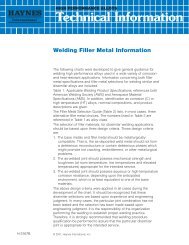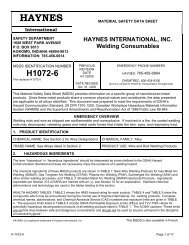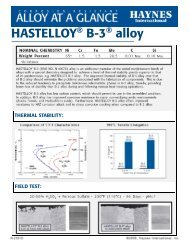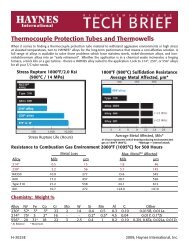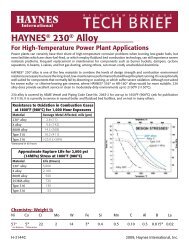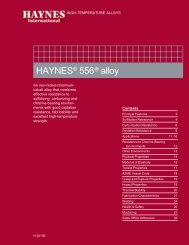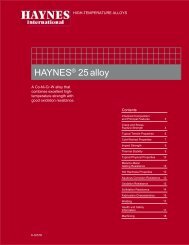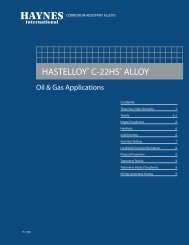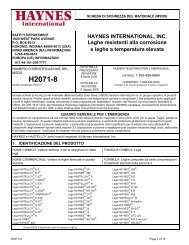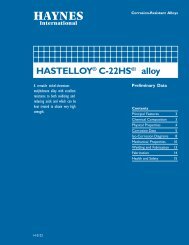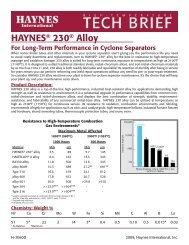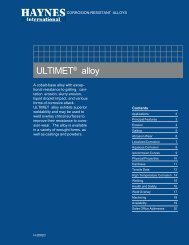HAYNES® HR-160® alloy - Haynes International, Inc.
HAYNES® HR-160® alloy - Haynes International, Inc.
HAYNES® HR-160® alloy - Haynes International, Inc.
Create successful ePaper yourself
Turn your PDF publications into a flip-book with our unique Google optimized e-Paper software.
MACHINING<br />
HAYNES ® <strong>HR</strong>-160 ® <strong>alloy</strong> is<br />
similar in machining characteristics<br />
to other solid-solutionstrengthened<br />
nickel-base <strong>alloy</strong>s.<br />
These <strong>alloy</strong>s as a group are<br />
classified as moderate to<br />
difficult to machine; however,<br />
Normal Roughing (Turning / Facing)<br />
Use carbide C-2 / C-3 grade tool<br />
Speed: 90 surface feet / minute<br />
Feed: 0.010 in. / revolution<br />
Depth of cut: 0.150 in.<br />
Finishing (Turning / Facing)<br />
Use carbide C-2 / C-3 grade tool<br />
Speed: 95-110 surface feet / minute<br />
Feed: 0.005-0.007 in. / revolution<br />
Depth of cut: 0.040 in.<br />
Drilling<br />
Use high speed steel M-33 / M-40 series 6 / or T-<br />
15 grades*<br />
Speed: 10-15 surface feet / minute (200 RPM<br />
maximum for 1/4 in. diameter or smaller)<br />
Lubricant: oil or water-base. Use coolant feed<br />
drills if possible.<br />
it should be emphasized that<br />
they can be machined using<br />
conventional methods at<br />
satisfactory rates. As these<br />
<strong>alloy</strong>s will work-harden rapidly,<br />
the keys to successful machining<br />
are to use lower speeds and<br />
21<br />
feeds, and to take heavier cuts<br />
than would be used for machining<br />
stainless steels. See<br />
<strong>Haynes</strong> <strong>International</strong> publication<br />
H-3159 for more detailed<br />
information.<br />
Negative rake square insert, 45° SCEA 1<br />
1/32 in. nose radius. Tool holder: 5° negative<br />
back and side rakes.<br />
Lubricant: Dry 2 , oil 3 or water-base 4,5 .<br />
Positive rake square insert, if possible,<br />
45° SCEA 1 1/32 in. nose radius. Tool holder:<br />
5° positive back and side rakes.<br />
Lubricant: Dry or water-base.<br />
Short, heavy-web drills with 135° crank shaft<br />
point. Thinning of web at point may reduce<br />
thrust.<br />
Feed:<br />
0.001 in. rev. 1/8 in. dia.<br />
0.002 in. rev. 1/4 in. dia.<br />
0.003 in. rev. 1/2 in. dia.<br />
0.005 in. rev. 3/4 in. dia.<br />
0.007 in. rev. 1 in. dia.<br />
*Carbide drills not recommended, but may be used in some set-ups. See <strong>Haynes</strong> <strong>International</strong> publication H-3159 for details.<br />
Notes: 1 SCEA - Side cutting edge angle, or lead angle of the tool.<br />
2 At any point where dry cutting is recommended, an air jet directed on the tool may provide<br />
substantial tool life increases. A water-base coolant mist may also be effective.<br />
3 Oil coolant should be a premium quality, sulfochlorinated oil with extreme pressure additives.<br />
A viscosity at 100°F of from 50 to 125 SSU is standard.<br />
4 Water-base coolant should be a 15:1 mix of water with either a premium quality, sulfochlorinated<br />
water soluble oil or a chemical emulsion with extreme pressure additives.<br />
5 Water-base coolants may cause chipping or rapid failure of carbide tools in interrupted cuts.<br />
6 M-40 series High Speed Steels include M-41 through M-46 at time of writing, others may<br />
be added, and should be equally suitable.<br />
HAYNES ® <strong>HR</strong>-160 ® <strong>alloy</strong>




